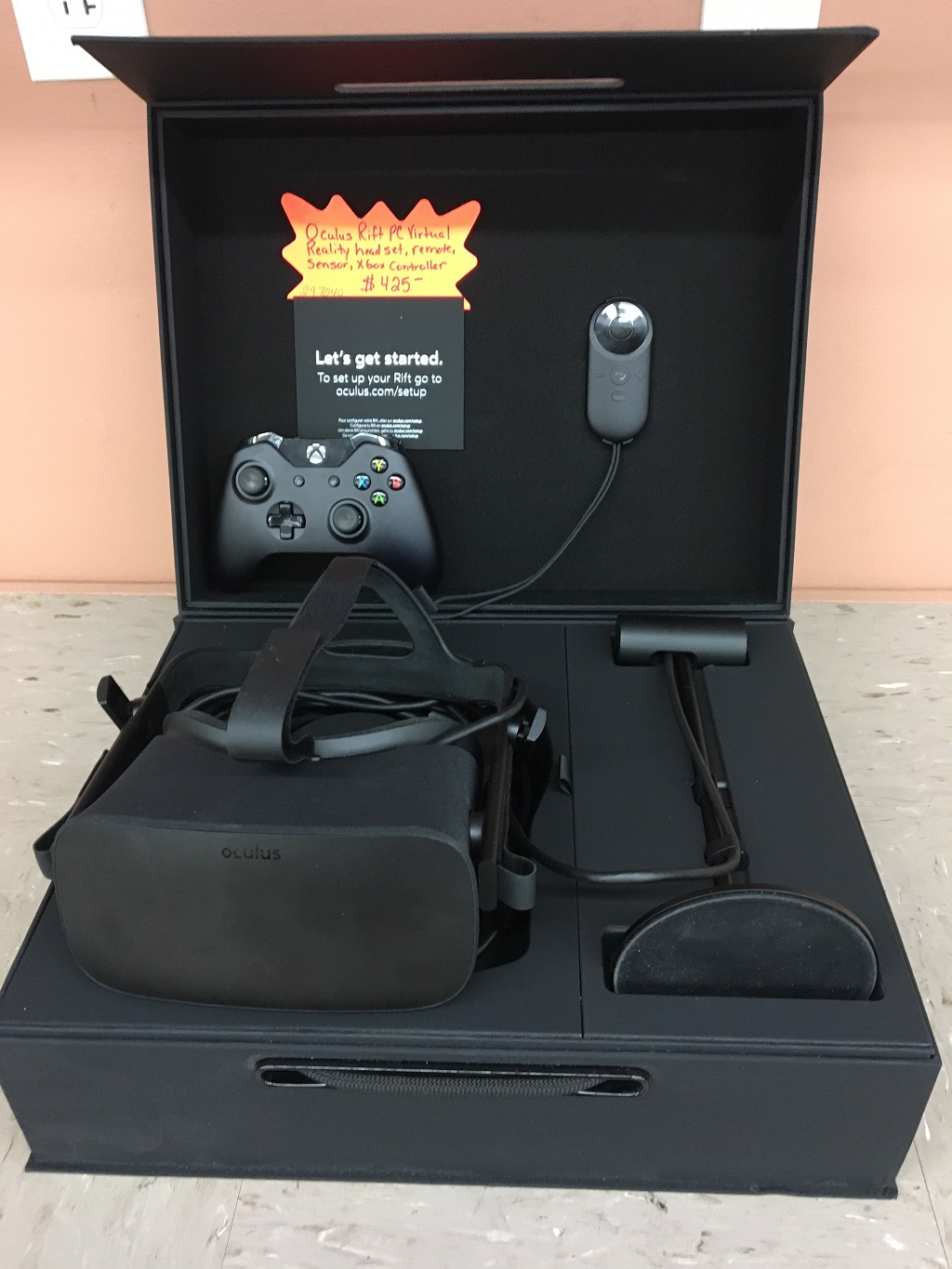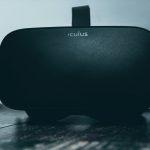Oculus Rift

Oculus Rift PC Virtual reality headset. Comes with headset, remote, sensor & XBox one controller $ 425
Did you know that virtual reality (VR) gaming, using 3d videos and device, is revolutionizing the way we experience video games? One of the most popular VR headsets on the market today is the Oculus Rift, a device known for its consumer-friendly price. With its cutting-edge technology and immersive gameplay, the Oculus Rift device has taken the gaming world by storm.
From its high-resolution display and precise tracking system to its comfortable design and extensive game library, this VR headset device offers unparalleled gaming experience with its hardware support and content. Whether you’re a hardcore gamer or simply looking to explore new realms, the Oculus Rift device has something for every consumer, with support for a wide range of content.
Join us as we explore the world of virtual reality through the lens of the Oculus Rift device, supported by captivating content for the consumer. Discover how this groundbreaking device is transforming gaming as we know it and why it’s a must-have for any gaming enthusiast, consumer, and user. It also has great support for content.
Evolution Journey
Initial Prototypes
In 2011, Oculus Rift, a consumer device, began its evolution journey in Palmer Luckey’s garage with the support of content. The initial prototypes of the device showcased innovative features that laid the foundation for virtual reality content as we know it today. These early versions of the Oculus Rift boasted high-speed Inertial Measurement Units (IMUs), wide-Field of View (FOV) optics, and content. These advancements allowed users to experience a more immersive, realistic virtual world content.
One of the significant milestones in the development of Oculus Rift was the release of Development Kit 1 (DK1) content. This kit introduced improved screen technology, which further enhanced the visual quality of the virtual reality experience. With DK1, users could truly immerse themselves in a virtual environment like never before with content.
HD Evolution
As Oculus Rift continued to evolve, it brought higher resolution and content to the table with the Development Kit 2 (DK2). This upgrade allowed for a more detailed, lifelike, and visually immersive experience with the content. Alongside improved resolution, positional tracking was also introduced, enabling users to move around in virtual space with greater freedom and accuracy.
Another notable improvement in the HD evolution of Oculus Rift was the introduction of detachable cables, enhancing the overall content experience. This feature made it easier for users to connect and disconnect their VR headset without any hassle, content. By eliminating cable constraints, Oculus Rift offered a more comfortable and convenient experience.
With these advancements, Oculus Rift solidified its position as a leading player in the virtual reality industry, providing users with an even more immersive and captivating VR experience.
Crescent Bay
Crescent Bay marked another significant milestone in the evolution of Oculus Rift. This prototype introduced several unique features and improvements that pushed the boundaries of virtual reality technology. It featured advanced head-tracking capabilities, allowing for more precise and responsive movement tracking.
Crescent Bay also showcased improvements in display technology, delivering even sharper visuals and reducing motion blur. The prototype’s integrated audio system provided spatial sound, further enhancing the immersive experience. These advancements in Crescent Bay set the stage for future Oculus Rift models, shaping the direction of virtual reality technology.
Rift S Updates
The latest iteration of Oculus Rift, the Rift S, continues to build upon the foundation laid by its predecessors. It brings a host of improvements and features that enhance the virtual reality gaming experience. The Rift S offers higher-resolution displays, resulting in clearer and more vibrant visuals.
One notable update in the Rift S is the introduction of inside-out tracking, which eliminates the need for external sensors. This allows for easier setup and more flexibility in positioning the VR headset. Ergonomic improvements such as a redesigned head strap and improved weight distribution contribute to a more comfortable and enjoyable user experience.
With these technological advancements, Oculus Rift S takes virtual reality gaming to new heights, providing users with an immersive and seamless VR journey.
Oculus Unavailability
Rift S Status
The Oculus Rift S, a popular virtual reality headset, has undergone significant changes in its availability and status in the market. As of [current date], the Rift S is no longer being produced or sold by Oculus VR. This discontinuation has left many users and potential buyers wondering about the reasons behind this decision and what it means for the future of Oculus VR.
One of the main factors contributing to the discontinuation of the Rift S is the release of newer and more advanced virtual reality headsets by Oculus VR. The company has shifted its focus towards their latest flagship product, the Oculus Quest 2. With its standalone capabilities and improved performance, the Quest 2 offers a more accessible and versatile VR experience compared to its predecessor.
The Rift S faced some limitations that may have influenced Oculus VR’s decision. The Rift S required a powerful gaming PC to operate, which added an extra cost for consumers who didn’t already own one. This requirement made it less appealing to a wider audience who were looking for a more plug-and-play experience.
The discontinuation of the Rift S does not mean that existing owners will be left without support. Oculus VR has stated that they will continue to provide software updates and customer support for current Rift S users. However, new units will no longer be manufactured or sold by the company.
Looking ahead, this shift in focus towards standalone headsets like the Quest 2 signals a strategic move by Oculus VR to reach a broader market. By eliminating the need for external hardware, they are making virtual reality more accessible to casual users who may not have gaming PCs or technical expertise.
Advancing Technology
Software Features
Oculus Rift offers a wide range of software features that enhance the virtual reality experience for users. These features are designed to immerse users in a virtual world like never before. With Oculus Rift, you can explore breathtaking environments, engage in thrilling games, and interact with virtual objects.
One of the standout features of Oculus Rift software is its compatibility with a diverse range of applications and games. Whether you’re interested in exploring new worlds, solving puzzles, or experiencing heart-pounding adventures, there is something for everyone. From popular gaming titles to educational experiences and creative tools, the software library for Oculus Rift continues to expand, offering endless possibilities for users.
By utilizing the positional tracking technology of Oculus Rift, the software allows for precise head and hand movements to be translated into the virtual world. This means that as you move your head or reach out your hand, the virtual environment responds accordingly, creating a truly immersive experience. Imagine feeling like you’re actually inside a game or exploring a virtual museum with stunning realism.
SDK Functionality
The Software Development Kit (SDK) plays a crucial role in advancing the functionality of Oculus Rift. The SDK provides developers with the necessary tools and resources to create immersive virtual reality experiences. It allows them to harness the full potential of Oculus Rift’s hardware capabilities and bring their creative visions to life.
With the SDK, developers can access APIs (Application Programming Interfaces) that enable them to integrate various features into their applications or games. These APIs include functions for rendering 3D graphics, handling user input through sensors and controllers, implementing audio effects, and much more. By leveraging these functionalities, developers can create highly interactive and realistic virtual environments that captivate users’ senses.
Furthermore, the SDK offers comprehensive documentation and tutorials that guide developers through every step of the development process. This ensures that even those new to virtual reality development can quickly get up to speed and start creating compelling experiences. The SDK also provides debugging tools and performance optimization features, allowing developers to fine-tune their applications for optimal performance on Oculus Rift.
System Requirements
To ensure a smooth and seamless virtual reality experience on Oculus Rift, it is essential to meet the system requirements specified by the device. These requirements are designed to ensure that your hardware can handle the demanding nature of virtual reality applications and games.
The recommended system requirements for Oculus Rift include a powerful gaming PC with a high-performance graphics card, sufficient RAM, and a fast processor. You will need multiple USB ports for connecting the headset and sensors, as well as an HDMI port for video output. It’s important to note that Oculus Rift requires a dedicated VR-ready PC or laptop to function properly.
Diverse Applications
Beyond Gaming
Media Use
-
Oculus Rift is not just limited to gaming; it has also revolutionized media consumption.
-
The immersive experiences offered by Oculus Rift have transformed the way we watch movies and videos.
-
With Oculus Rift, media content creators can now leverage virtual reality for innovative storytelling.
Social Interaction
-
Oculus Rift goes beyond solitary gaming experiences by offering social interaction features.
-
Virtual social gatherings and interactions are facilitated through the platform, enhancing the sense of community.
-
Users can engage with friends and strangers alike, fostering connections in a virtual environment.
Professional Utilization

Industrial Use
-
The applications of Oculus Rift extend far beyond gaming, finding utility in various industries.
-
Industries utilize Oculus Rift for training, simulation, and design purposes, revolutionizing their processes.
-
Virtual reality technology has had a significant impact on industrial sectors, enhancing efficiency and effectiveness.
TV Industry
-
The television industry has embraced the integration of Oculus Rift technology.
-
Audiences can now engage with TV content in entirely new ways thanks to the immersive experience provided by Oculus Rift.
-
As the technology evolves, we can expect further developments that will reshape the future of TV viewing.
Gaming Revolution
VR Gaming Library
Dive into the extensive virtual reality gaming library available for Oculus Rift. With its cutting-edge technology, Oculus Rift offers a wide range of immersive gaming experiences that transport you to another world. Whether you’re a fan of action-packed adventures, thrilling horror games, or mind-bending puzzles, the VR gaming library has something for everyone.
Explore the diverse genres and titles offered in the Oculus Rift gaming library. From heart-pounding first-person shooters to captivating story-driven narratives, there is no shortage of options to choose from. Immerse yourself in realistic environments and engage with virtual characters like never before.
One of the highlights of the Oculus Rift gaming library is the exclusive gaming experiences tailored specifically for Oculus Rift users. These exclusive titles take full advantage of the headset’s capabilities, offering unparalleled immersion and interactivity. Step into the shoes of a superhero, pilot a spaceship through the vastness of space, or embark on an epic quest in a fantasy realm – the possibilities are endless.
PC-powered Gaming
Understand the advantages of PC-powered gaming with Oculus Rift. By harnessing the power of your PC, you can enjoy high-quality graphics and performance that elevate your gaming experience to new heights. The combination of Oculus Rift’s advanced hardware and your powerful computer creates a synergy that delivers stunning visuals and smooth gameplay.
Explore the high-quality graphics and performance offered by PC-powered Oculus Rift games. With powerful processors, dedicated graphics cards, and ample RAM, your PC can handle even the most demanding virtual reality games with ease. Experience lifelike visuals, realistic physics simulations, and seamless gameplay that blur the line between reality and virtuality.
One of the great benefits of PC-powered gaming with Oculus Rift is its compatibility with a wide range of PC gaming setups. Whether you have a high-end gaming rig or a more modest setup, you can still enjoy all that Oculus Rift has to offer. The flexibility and scalability of PC gaming allow you to tailor your virtual reality experience to your own preferences and budget.
Non-Gaming Impact
Sports Integration
Virtual reality technology has not only revolutionized the gaming industry but also made a significant impact on the world of sports. Oculus Rift, with its immersive capabilities, is at the forefront of this integration. With Oculus Rift, sports enthusiasts can now experience their favorite games and events like never before.
The integration of Oculus Rift in sports opens up a whole new realm of possibilities. Users can step into the shoes of their favorite athletes and experience the thrill of playing in front of thousands of cheering fans. Whether it’s basketball, soccer, or even extreme sports like snowboarding, Oculus Rift delivers an unparalleled level of immersion.
Imagine being able to play alongside your favorite basketball stars, feeling the rush as you dribble down the court and make that game-winning shot. With Oculus Rift, this dream becomes a reality. The technology tracks your movements and translates them into virtual actions, allowing you to fully immerse yourself in the game.
But it doesn’t stop there. Oculus Rift also offers users the opportunity to watch live sports events from the comfort of their own homes. Through virtual reality broadcasts, viewers can feel like they are sitting courtside or in the front row of a stadium, experiencing every moment as if they were physically present.
The impact of sports integration on virtual reality technology is immense. It not only enhances the entertainment value for sports fans but also provides unique training opportunities for athletes. With Oculus Rift, players can simulate game scenarios and practice their skills in a realistic virtual environment.
Casinos Integration
Virtual reality has also found its way into the casino industry through innovative integration with Oculus Rift technology. This exciting development takes traditional casino gaming to a whole new level by providing an immersive and interactive experience for players.
With Oculus Rift, players can step into a virtual casino and explore a wide range of games without leaving their homes. From slot machines to poker tables, every aspect of the casino experience is brought to life in stunning detail. The technology allows players to interact with the virtual environment, making it feel like they are physically present in the casino.
The unique features of Oculus Rift enhance the casino gaming experience in several ways. Players can enjoy realistic graphics and sound effects, creating a truly immersive atmosphere. They can also interact with other players in real-time, adding a social element to the gaming experience.
Virtual reality casinos offer a wide range of opportunities for players. Whether you’re a seasoned gambler or new to the world of casinos, Oculus Rift provides an exciting and engaging platform to enjoy your favorite games. The technology allows for innovative gameplay mechanics and unique experiences that cannot be replicated in traditional brick-and-mortar casinos.
Community Reception
VR Community Feedback
User feedback plays a crucial role in shaping the Oculus Rift experience. The developers at Oculus value the opinions and suggestions of their community, recognizing that they are the ones who will be using their products. By actively engaging with users, Oculus Rift has been able to gather valuable insights on what works well and what needs improvement.
The feedback received from the VR community has directly influenced the development of Oculus Rift products. Through user surveys, forums, and direct communication channels, enthusiasts have shared their thoughts on various aspects of the headset, such as comfort, visual quality, and ease of use. This feedback has allowed Oculus Rift to identify areas for enhancement and prioritize features that matter most to their users.
In response to community feedback, Oculus Rift has implemented numerous improvements based on user suggestions. For instance, users expressed a desire for increased portability, prompting Oculus Rift to develop a more compact and lightweight design for their latest models. Through ongoing dialogue with the community, Oculus Rift has refined its tracking technology and addressed concerns related to motion sickness and eye strain.
Competitive Edge
Oculus Rift maintains a competitive edge in the virtual reality market by offering cutting-edge technology and innovative features. One key advantage is its commitment to providing high-quality visuals. With advanced display technologies and high-resolution screens, Oculus Rift delivers immersive experiences with stunning graphics that rival reality.
Another area where Oculus Rift stands out is its extensive library of games and applications. By partnering with developers and studios, Oculus Rift offers a wide range of content that caters to diverse interests and preferences. From action-packed adventures to educational simulations, there is something for everyone in the Oculus Store.
To stay ahead of competitors, Oculus Rift continuously pushes the boundaries of virtual reality technology. They invest heavily in research and development to introduce new features like hand tracking and improved haptic feedback. By constantly innovating and introducing advancements in hardware and software, Oculus Rift ensures that its users have access to the latest and most immersive VR experiences available.
Legal Challenges
ZeniMax Lawsuit
The ZeniMax lawsuit has been a significant legal challenge for Oculus Rift. This lawsuit, filed in 2014, alleged that Oculus Rift stole trade secrets and technology from ZeniMax, a video game publisher. The implications of this lawsuit were far-reaching, as it not only threatened the reputation of Oculus Rift but also had the potential to undermine the entire virtual reality industry.
The details of the ZeniMax lawsuit revealed a complex web of allegations and counterclaims. ZeniMax claimed that Oculus Rift founder Palmer Luckey had used their proprietary information to develop the virtual reality headset. They argued that John Carmack, a former employee of ZeniMax who later joined Oculus Rift, had improperly shared confidential information with Luckey.
This legal battle brought into question the ownership and origin of key technologies used in virtual reality. It raised concerns about intellectual property rights and the need for clear boundaries between companies in this rapidly evolving field. The outcome of this lawsuit would have significant consequences for not only Oculus Rift but also for other players in the virtual reality market.
In 2017, after years of litigation, a jury ruled in favor of ZeniMax and awarded them $500 million in damages. This ruling sent shockwaves through the virtual reality industry and raised doubts about the future of Oculus Rift. However, Oculus Rift appealed the decision, and eventually settled with ZeniMax for an undisclosed amount.
The resolution of the ZeniMax lawsuit marked an important turning point for Oculus Rift. It allowed them to put this legal battle behind them and focus on further developing their virtual reality technology. While this lawsuit undoubtedly caused setbacks and damaged their reputation, it also served as a learning experience for Oculus Rift.
Personalizing Experience

User Customization
Discover the customization options available for users on Oculus Rift. The Oculus Rift offers a range of tools and features that allow users to personalize their virtual reality experience. By customizing various aspects of the VR environment, users can truly make it their own.
One of the key ways users can customize their experience is through visual customization. Oculus Rift provides a variety of themes, backgrounds, and color schemes that users can choose from to create a visual atmosphere that suits their preferences. Whether you prefer a sleek and minimalistic look or a vibrant and dynamic setting, there is an option for everyone.
In addition to visual customization, audio customization plays a crucial role in enhancing the immersive experience on Oculus Rift. Users have the ability to adjust audio settings such as volume, equalizer presets, and spatial audio effects. This allows users to fine-tune the sound according to their personal preferences and create an audio environment that complements their virtual reality adventures.
Furthermore, Oculus Rift offers control customization options that enable users to tailor their interactions with the virtual world. Users can choose from various control schemes, including handheld controllers or even full-body tracking systems for more realistic movements. This level of customization ensures that users have control over how they navigate and interact within the virtual space.
To further enhance user comfort, Oculus Rift also provides physical customization options. The headset comes with adjustable straps and lenses, allowing users to find the perfect fit for their head shape and eye distance. This ensures a comfortable and immersive experience without any discomfort or strain during extended VR sessions.
Moreover, Oculus Rift supports software customization through its extensive library of applications and games. Users can explore different genres, themes, and experiences to find content that aligns with their interests. With a wide range of choices available, users can curate their own collection of VR experiences tailored specifically to their preferences.
Final Remarks
In conclusion, the Oculus Rift has revolutionized the gaming industry and has had a significant impact beyond just gaming. Its evolution journey from unavailability to advancing technology has allowed for diverse applications and a non-gaming impact that extends into various fields. The community reception has been overwhelmingly positive, despite some legal challenges along the way. Personalizing your experience with the Oculus Rift has never been easier, and the possibilities for immersive virtual reality are endless.
Now that you have learned about the incredible potential of the Oculus Rift, it’s time to take action. Dive into the world of virtual reality gaming and explore the vast array of experiences available. Whether you’re a casual gamer or a hardcore enthusiast, the Oculus Rift offers a truly immersive experience that will transport you to new worlds. Don’t miss out on this gaming revolution – grab your Oculus Rift and get ready to level up your gaming experience like never before!
Frequently Asked Questions
What is the evolution journey of Oculus Rift?
Oculus Rift has come a long way since its inception, evolving from a Kickstarter project to a groundbreaking virtual reality (VR) headset. With advancements in technology and continuous innovation, it has transformed the way we experience digital content, revolutionizing the gaming and non-gaming industries.
Why is Oculus Rift currently unavailable?
Oculus Rift may be temporarily unavailable due to high demand or production constraints. However, Oculus works diligently to ensure availability and strives to meet the growing demand for their VR headsets. Keep an eye out for updates on their website or authorized retailers for availability information.
How is the advancing technology shaping the future of Oculus Rift device, hardware, and support for 3D videos?
Advancing technology plays a pivotal role in shaping the future of Oculus Rift. With each iteration, improvements in display resolution, tracking accuracy, comfort, and performance enhance the overall virtual reality experience. As technology continues to progress, users can expect even more immersive and realistic virtual worlds.
What are some diverse applications of Oculus Rift?
Oculus Rift extends beyond gaming, finding applications in various industries such as education, healthcare, architecture, and training simulations. It enables immersive experiences that facilitate learning, visualization, therapy, design prototyping, and skill development across different fields.
How does Oculus Rift contribute to the gaming revolution?
Oculus Rift has revolutionized gaming by offering unparalleled immersion and presence in virtual worlds. With its precise tracking system and intuitive controllers, players can physically interact with their surroundings like never before. The lifelike visuals and immersive audio create an unparalleled gaming experience that transports players into new realms of entertainment.
How does Oculus Rift have a non-gaming impact?
Beyond gaming, Oculus Rift has made significant strides in non-gaming sectors. It has been utilized for virtual travel experiences, social interactions through VR chat platforms, virtual concerts or events attendance from home, therapeutic applications for anxiety or phobias treatment—the possibilities are vast, showcasing the versatility and potential of virtual reality technology.
How has the community reception been towards Oculus Rift?
The community’s reception towards Oculus Rift has been overwhelmingly positive. Gamers, developers, and enthusiasts have embraced the immersive experiences offered by the VR headset. The strong support from the community has fostered a vibrant ecosystem of content creation, with an ever-growing library of games, applications, and experiences available for users to enjoy.
What legal challenges surround Oculus Rift?
Oculus Rift faced legal challenges in its early stages, primarily concerning intellectual property disputes. However, through legal settlements and ongoing partnerships, many of these challenges have been resolved. Oculus continues to prioritize compliance with legal regulations to ensure a seamless user experience while pushing the boundaries of virtual reality technology.
How can one personalize their experience with Oculus Rift?
Users can personalize their experience with Oculus Rift through various means. Customizable settings allow adjustments for comfort, visual clarity, and audio preferences. Users can explore a wide range of games and applications tailored to their interests and preferences, ensuring a personalized and enjoyable virtual reality journey.

